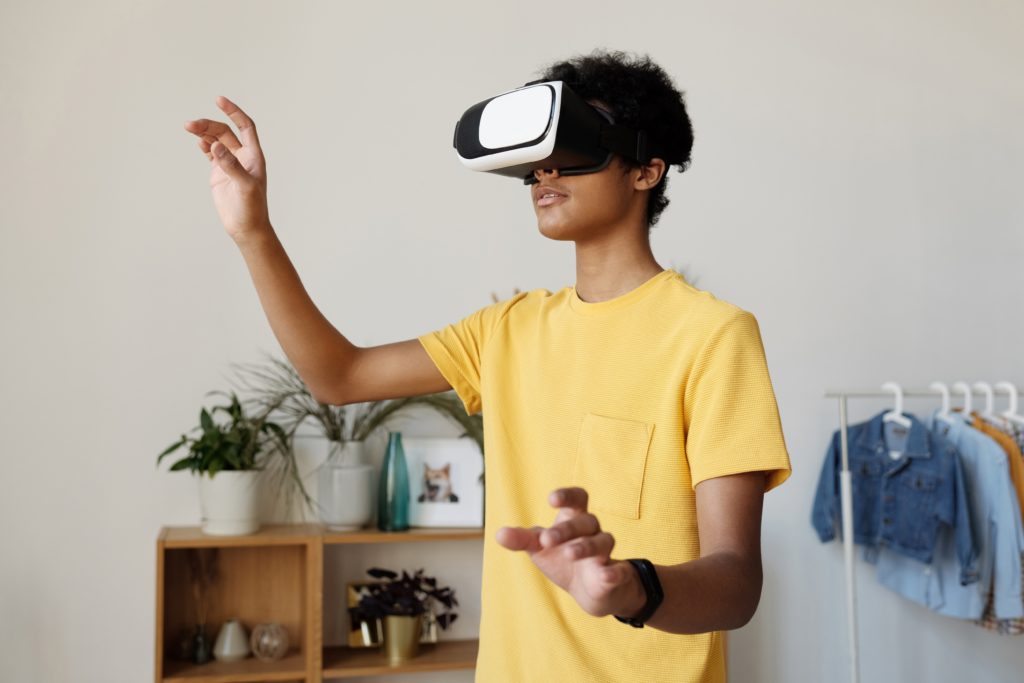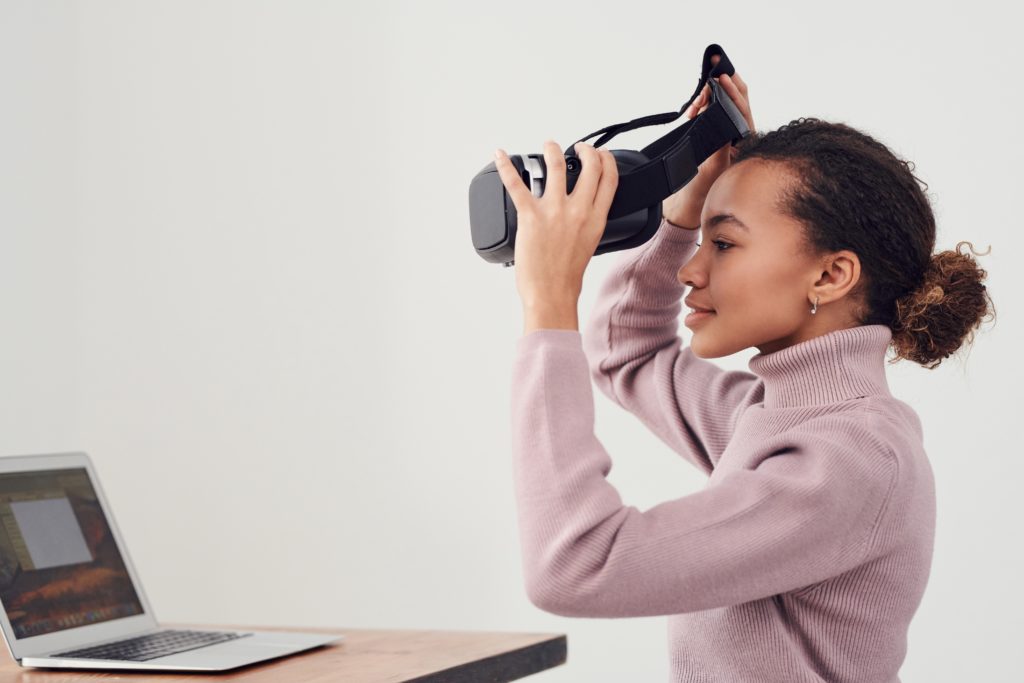The biggest fear that crosses most people’s minds before they try virtual reality is whether or not it’s bad for your eyes. Will it hurt your eyes? Can you go blind? What can VR do to your eyes? The list goes on. It’s clear to me why these thoughts go through our minds. It doesn’t take me long to cast my thoughts back to my childhood to remember where these ideas came from.
Picture this, a bright-eyed scamp who wakes up at the crack of dawn on a Saturday morning. Sneaking downstairs trying not to wake anyone. Pouring a bowl of cereal and making a mess a mini hurricane would be proud of. Then plopping a cushion right in front of the TV and sitting as close as possible while playing video games. Eyeballs inches from the curved glass as I played Super Mario on the SNES trying to keep the volume low so as not to wake anyone.
No need for 65-inch LCD TVs back then when your sitting as close to the tell you can feel it buzz with electricity. Of course, the harmonious experience was always short-lived. My mother or father would soon discover me and the reaction was always the same. ‘Don’t sit so close to the screen you’ll hurt your eyes!’ was always the phrase used to scold me. Thankfully, I rarely listened but it did instill that slight fear in the back of my mind.
Roll on a number of years (I won’t say how many) and as I strap a shiny Meta Quest 2 or a Valve Index or even an Oculus Rift S to my face with lends just millimeters from my eyes…the same nagging voice is still there at the back of my mind. Don’t sit so close to the screen you’ll go blind! So is VR bad for your eyes? Can virtual reality hurt your eyesight? Can you go blind? Well let’s find out together, shall we? That younger version of me demands answers, so let’s dive right in!
Can Virtual Reality Hurt Your Eye? – The Science Bit!

Research conducted by The American Academy of Ophthalmology came to the outcome that wearing virtual reality headsets for long periods can cause eye muscle strain, dryness or discomfort, eye fatigue, and blurred vision. The bright light shining from the lenses combined with the user’s focus in the game means that we tend to blink less and are more susceptible to strain and dryness. Not a nice thing to read for all of us avid virtual reality fans, is it?
The good news though is that none of the effects listed above are permanent. Virtual reality doesn’t do any lasting damage and with regular breaks between gaming sessions and a little common sense, you can avoid any of the symptoms listed above. Eye drops to keep your eyes lubricated are recommended not just for VR users, but for everyone going about their day-to-day lives. Any activity that causes you to concentrate more and stare can lead to eye strain. To counter this, it’s recommended that you take short breaks and stare in the middle distance (out a window preferably) for a minute or two. This applies to all screens like laptops and TVs and not just virtual reality.
Motion Sickness – A More Prominent Side Effect of VR
Eye strain aside, you are much more likely to feel the effects of motion sickness when using virtual reality. The issue with motion sickness is that it doesn’t just build over a long play session, it can occur all at once depending on the on-screen action. Motion sickness can be immediate which makes it far more difficult to manage than eye strain. Sadly, once you get motion sickness from VR it’s generally not a case of taking a two-minute break. The discomfort and queasy feeling in your stomach can last for hours. Suggested remedies include ginger and warm drinks, but the effects of motion sickness are more severe than eye strain or blurry vision.
Motion sickness occurs in VR when the brain gets mixed signals. The immersion shows movement and yet your body is stationary which causes the upset. Earlier versions of virtual reality were more prone to users getting motion sick as the refresh rate and the resolution weren’t good enough. Nowadays the effects of motion sickness are lessened as technology has advanced so much. Also, game developers have been clever enough to include in-game options to help counter motion sickness. Click turning, blinkers, and teleporting are movement options included in most modern VR titles. It is only games with smooth motion and fast action that may still cause discomfort in players. As long as you are aware of your tolerance and comfort levels though, it is now much easier to protect yourself from getting motion sickness while playing virtual reality.
VR Damaged My Eyesight – A Claim From A VR User
Back in 2020, a virtual reality developer by the name of Danny Bittman complained that after wearing his headset for hours each day, he had damaged his eyesight. Over three years, Danny claimed his eyesight had deteriorated rapidly and blamed the change in his vision on virtual reality. Claims like this coming from a reputable VR developer are startling. However, on further investigation by the BBC, they reported that there was no supporting evidence to back up Danny’s claims. Further to that studies from The American Academy of Ophthalmology show that there is no evidence of any long-term or lasting effects on your eyes from using virtual reality even on a regular daily basis.
Danny Bittman’s claims although disproven did have a lasting damaging effect on the industry, however. Surveys completed by parents in 2017 by the nonprofit group known as ‘Common Sense’ showed that 8% of parents with kids aged 8-17 who used VR had reported that their children suffered from eye strain from using the virtual reality headset.
This led to an industry standard being set and a worldwide recommendation that no child under the age of 13 should be allowed to use VR headsets. An amazing example of erring on the side of caution as it was never made clear if anyone had ever suffered any lasting effects from using VR. Nor was it ever proven that VR is any worse than playing video games, staring at tablets or screens, or watching television for young children. A later report published in 2020 also contradicts the idea that VR causes eye strain in young children as it was found that after full VR immersion, there were no noteworthy effects or lasting eye strain for any of the test subjects.
VR Guidance – Things To Live By In VR
So no matter which side of the fence you’re on, the cautious nature of the VR manufacturers should be applauded. Even with no evidence of strain, the age recommendation for VR is 13 or above which is a good thing unless you’re 12! Perhaps the guidelines will relax over the coming years as we all get more familiar with virtual reality. Perhaps Mark Zuckerberg will mandate that all unborn children sign up for Meta and get a free headset once delivered (unlikely).
If you’re worried about using VR headsets or what impact or side effects they may have, then take a look at some helpful tips below. Let common sense prevail and use your judgment as nobody knows their own body better. If something feels uncomfortable then stop. But do not be afraid to try out virtual reality as it’s an absolute blast. Also, your mother was wrong…you won’t go blind!
Top Tips to Protect your Eyes
- Blink often to refresh and lubricate your eyes. Most users blink less than usual when wearing a virtual reality, which can lead to dryness in the eyes. Blinking produces tears that moisten and refresh your eyes. Try to make a conscious effort to blink more often when using VR.
- Take eye breaks. Throughout your play session, give your eyes a rest by taking off the headset for short periods. Try the 20-20-20 rule: Every 20 minutes, look at something 20 feet away for at least 20 seconds.

- Use artificial tears. Non-prescription artificial tears otherwise known as eye drops can help prevent and relieve dry eyes. Use them often daily even when your eyes feel fine to keep them well lubricated and prevent a recurrence of dryness. Your optician or pharmacist can suggest which eye drops might be best for you. Avoid eye drops with a redness remover, as these may worsen dry eye symptoms. Eye drops that don’t contain preservatives can be used as often as you need. If you use eye drops containing preservatives, you may develop a sensitivity to the preservative if you use the drops more than four times a day. If this occurs, switch to a non-preservative-based eye drop to see if it works better for you. However, don’t exceed the use stated on the label, and always check the expiry date.
- Improve the air quality in your play space. Some changes that can help prevent dry eyes include using a humidifier, adjusting the thermostat to reduce blowing air, and avoiding smoke. If you smoke, consider quitting. Moving your chair to a different area may help reduce the amount of dry moving air on your eyes and face. If playing standing, perhaps position yourself in a well-ventilated space or consider opening a nearby window.
- Alternative medicine. Some eyestrain symptoms can be relieved by natural products or home remedies. Ingredients such as the Omega-3 fatty acids in fish oil have been known to work well but have no official approval for treatment. Consult with your eye specialist first and get an expert opinion if you’re considering supplements or home remedies to help relieve eye soreness or strain.

That’s our advice. VR can be a truly wonderful experience if you apply a little common sense and take regular breaks. If you’d like to read about other things that your mom said would make you go blind, then check out these links below:
https://www.vrbeginnersguide.com/vr-bangers-review-discount-price-app-and-more/
https://www.vrbeginnersguide.com/best-vr-sex-toys-for-men-women/






